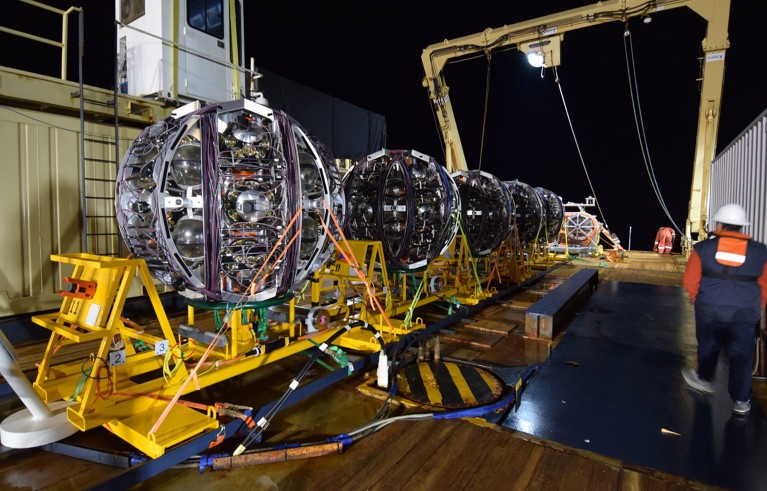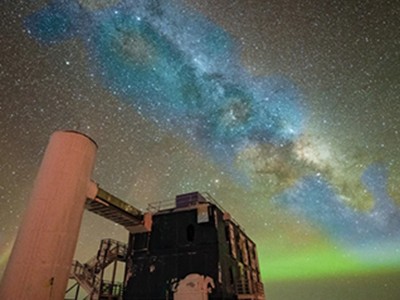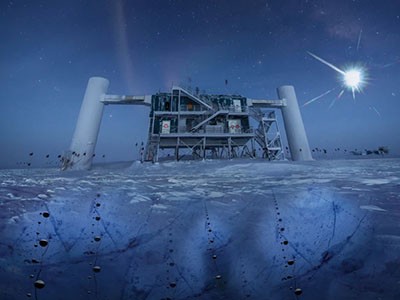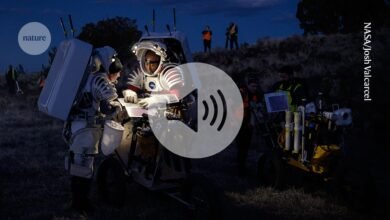‘Fantastic’ particle could be most energetic neutrino ever detected


Five ARCA detectors on board a ship, ready for deployment.Credit: KM3NeT Collaboration
An observatory still under construction at the bottom of the Mediterranean Sea has spotted what could be the most energetic neutrino ever detected. Such ultra-high-energy neutrinos — tiny subatomic particles that travel at nearly the speed of light — have been known to exist for only a decade or so, and are thought to be messengers from some of the Universe’s most cataclysmic events, such as growth spurts of supermassive black holes in distant galaxies.
Neutrino physicist João Coelho stunned researchers at the Neutrino 2024 conference in Milan, Italy, on 18 June, when he revealed the discovery only at the very end of his talk.
The most unusual portrait of the Milky Way yet: mapping the Galaxy with neutrinos
The neutrino detection was “a fantastic event”, says Francis Halzen, a physicist at the University of Wisconsin–Madison. He added that the observation highlights the potential of the Astroparticle Research with Cosmics in the Abyss (ARCA) observatory — a forest of detectors on ‘strings’ attached to the 3,500-metre-deep sea floor southeast of the Italian island of Sicily.
The neutrino “really stands out, very far away from anything else”, said Coelho, who is at the AstroParticle and Cosmology Laboratory in Paris. He did not disclose the precise direction from which the particle had come, nor when the observation occurred: doing so could have tipped off competitors about the possible origin of the neutrino, researchers at the conference told Nature. Coelho instead promised that these details would be revealed in a paper further down the line. “It would be really interesting to see where in the sky the neutrino originated,” says Nepomuk Otte, a physicist at the Georgia Institute of Technology in Atlanta.
Beads on strings
ARCA is the larger component of a neutrino observatory called the Cubic Kilometre Neutrino Telescope (KM3NeT), which also includes an array off Toulon, France. The collaboration includes European countries together with Morocco, South Africa, Australia, Georgia, China and the United Arab Emirates.
ARCA has been collecting data since the mid-2010s, and currently consists of 28 strings, which the team hopes to expand to a total of 230 by 2028. Each string is 800 metres long, and beaded with 18 detector units — plexiglass spheres about half a metre wide, containing light detectors that can each sense just a handful of photons.
The majority of the light that ARCA detects is the result of highly energetic cosmic-ray particles, which produce showers of electrically charged subatomic particles when they hit Earth’s atmosphere. These particle showers can travel in water for kilometres and leave behind faint flashes of light, which ARCA is designed to spot.
Single subatomic particle illuminates mysterious origins of cosmic rays
The observatory can also detect light from other kinds of particle, including neutrinos. It does not ‘see’ neutrinos directly. Instead, when a neutrino hits a molecule — of air, water or underlying rock — it can create a highly energetic charged particle called a muon, which produces a shower of other charged particles as it moves through the detector. Neutrinos can travel through Earth, so the particle showers that they produce can come from any direction, whereas those resulting from cosmic rays tend to come from the atmosphere. So, when ARCA detects a shower from above, it can be difficult to determine the source, but showers that are horizontal or upwards-moving are most likely to be neutrinos, says Elisa Resconi, a neutrino physicist at the Technical University of Munich in Germany.
But for the highest-energy neutrinos — those carrying half a petaelectronvolt (0.5×1015 eV) or more — the Earth acts as a barrier, says Resconi. That leaves a strip of sky around the horizon where the Earth-skimming particles can be detected and easily distinguished from cosmic rays. “We have this narrow region in which we can see very clean signatures of these neutrinos,” says Resconi, who is part of the collaboration that discovered ultra-high-energy neutrinos around a decade ago; that group used the much larger IceCube Neutrino Observatory, a detector similar to ARCA that is embedded in Antarctic ice.
In his talk, Coelho said that more than one-third of ARCA’s sensors had recorded flashes consistent with a muon crossing the observatory horizontally, produced by a neutrino that arrived from around one degree below the horizon. The particle probably had an energy of many tens of petaelectronvolts, he added — which would make it the most energetic ever detected.
The search continues
At least four more observatories that can detect the highest-energy neutrinos are under construction or have been proposed, according to Naoko Kurahashi Neilson, a neutrino researcher at Drexel University in Philadelphia, Pennsylvania, who outlined some of the plans in a separate talk. Resconi says that she and her collaborators have been conducting successful tests for a future neutrino observatory off Vancouver Island, Canada. And Otte is leading another proposed project — with a prototype now being tested in Utah — that would search for Earth-skimming neutrinos by monitoring the atmosphere just above the horizon for flashes of light.
Until recently, only IceCube had the capability of seeing these extreme particles — which makes the detection by the much smaller ARCA all the more sensational. “It’s like winning the big lottery,” says Halzen, who is IceCube’s principal investigator.






